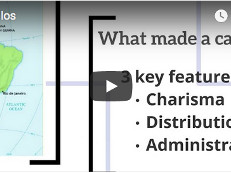My blog post is an examination of the term caudillo. Admittedly, I had little knowledge of the term, so here is my investigation.
While there is no universal definition that fits every caudillo under all circumstances, scholars generally agree on a cluster of attributes that most caudillos shared and that together provide a viable working definition of the caudillo phenomenon. In general, a caudillo was a political-military strongman who wielded political authority and exercised political and military power by virtue of personal charisma, control of resources such as land and property, the personal loyalty of his followers and clients, reliance on extensive clientage networks, the capacity to dispense patronage and resources to clients, and personal control of the means of organized violence. The keyword is personal: a caudillo was a type of leader, marked by his style of leadership, and most defined by the personal nature of his rule. Constitutions, state bureaucracies, representative assemblies, periodic elections—these and other institutional constraints on individual and personal power, commonly associated with modern state forms, all were antithetical to the caudillo style of rule, while also often coexisting in tension with it. Ideology mattered little.
A good example of a caudillo is Rosas. Scion of an elite porteño (Buenos Aires) Creole family, Rosas left the port city as a young man to become a cattle rancher. Rosas was opposed to the liberal, unitarian, modernizing regime of Bernardino Rivadavia, whose policies were designed to make Buenos Aire’s equal with the other provinces of the Río de la Plata. His opposition to Rivadavia was not rooted in ideology but in the belief that Buenos Aires should retain its superior power. With his base of support secure, Rosas allied with the federalists who overthrew Rivadavia. Soon after, he became the governor of Buenos Aires and then absolute dictator. His style of leadership was profoundly personal: All power and authority flowed directly from him.
There is no scholarly consensus on when the caudillo phenomenon ended, or even if it has ended. Some point to the first half of the 19th century as the heyday of caudillos and caudillismo; others argue that the phenomenon continued into the 20th century and after, transmuting into various forms of populism and dictatorship, and manifest in the likes of Juan Perón of Argentina, Fidel Castro of Cuba, and Hugo Chávez of Venezuela. Despite vigorous debates over definitions, origins, periodization, and other aspects, however, few disagree that understanding the phenomenon of the caudillo and caudillismo is essential to understanding the political evolution of post-independence Latin America.

